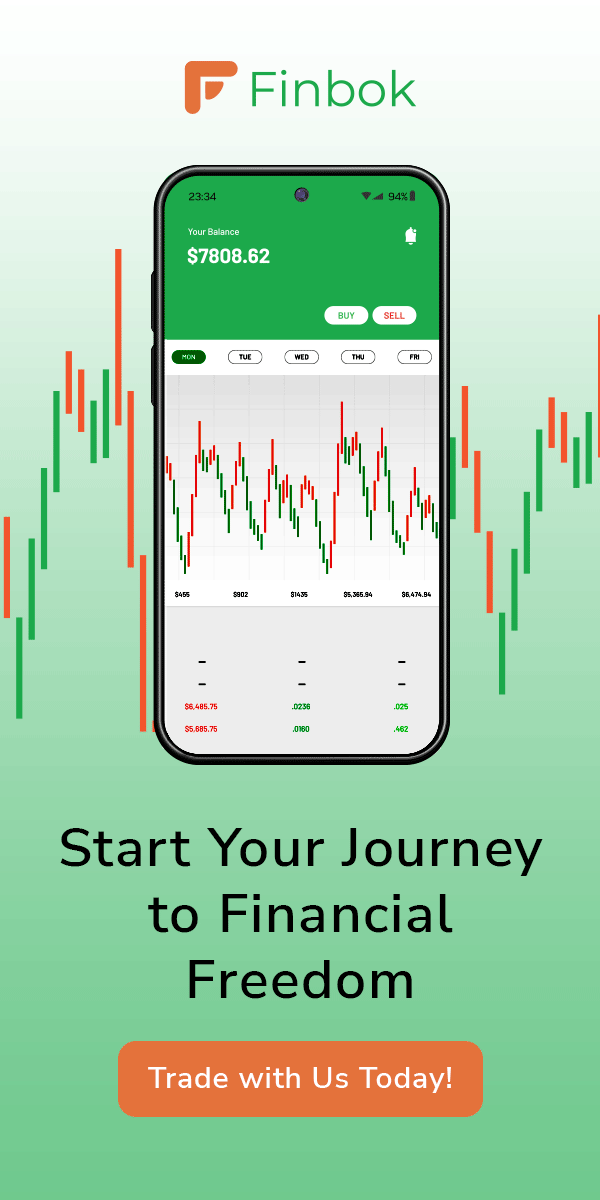Commodities trading is one of the biggest sectors of the financial markets. Commodities play a crucial role in South African’s daily lives, providing the food they eat and the energy they use to drive their cars.
Commodities trading uses any basic good to be traded in large quantities and interchangeable with other products of the same sort.
In this article, Finbok unpacks commodities trading and shares valuable advice and insights for traders.
Commodities Trading: How It Works
Commodities are either for immediate delivery in spot trading or for later delivery when traded as futures.
Metals (aluminum, copper, gold, lead, nickel, silver, zinc) and “soft” products (cocoa, coffee, sugar, oil, etc.) are traded on commodity markets.
Commodities provide investors with a valuable opportunity to diversify their portfolios beyond standard assets.
Because commodity prices tend to fluctuate in the opposite direction as stock prices, some investors rely on commodity returns during times of market volatility.
Historically, commodities trading took substantial amounts of time, money, and experience and was only available to professional traders.
Today, there are significantly more opportunities to participate in commodity markets.

Commodities Trading: Market Characteristics
Commodity markets are primarily driven by the fundamental principles of supply and demand.
Changes in supply have an impact on demand, and low supply leads to higher pricing.
As a result, any disturbances in a commodity’s supply, such as a virus that affects cattle or a cold snap in a citrus location like the Western Cape, can produce a jump in the commodity’s otherwise stable and predictable demand.
Global economic development and technological progress can have a significant impact.
For example, the rise of China and India as major manufacturers has resulted in massive increases in demand for industrial metals, making them more difficult to get in other regions of the world.
Commodities Trading: Types of Commodities
Commodities are classified into four categories:
1 Metals
2 Energy
3 Animals and meat
4 Agricultural items
Metal commodities consist of gold, silver, platinum, and copper.
During instances of market turbulence or bear markets, many investors place their money in precious metals, particularly gold, due to their reputation for having steady value.
Traders also do so to protect against high inflation or currency depreciation.
In recent years, the primary story in these commodities has been the tech industry’s demand for rare earth elements, in addition to the traditional trade in metal as a store of value and for industrial manufacturing.
Some elements, such as dysprosium, erbium, europium, gadolinium, and holmium, are utilized in speakers, electric car motors, and smartphones.
Gallium is another element that is commonly found in semiconductors and LEDs, while tantalum and niobium are required for the production of capacitors and resistors.
Without these metals, it is difficult to imagine how many modern things might have been miniaturized.

Commodities Trading: Metal Markets
Metals used in batteries, such as lithium, cobalt, and nickel, are in great demand for renewable energy storage.
As a result, there has been intense competition for access to these key metals.
For example, European, American, and Chinese companies have been sourcing some of these metals in several central African countries, including the Congo.
Commodities Trading: Energy commodities
Energy commodities are crude oil, heating oil, natural gas, and gasoline.
Global economic advances and lower oil outputs from established wells around the world have traditionally resulted in rising oil prices, as demand for energy-related items has increased while oil supplies have dwindled.
Traders interested in the energy sector should understand how economic downturns and shifts in production are mandated by the Organization of Petroleum Exporting Countries (OPEC).
Trades also need to understand that advances in alternative energy sources—wind power, solar energy, and biofuels, for example—all have a significant impact on market prices for energy commodities.
That is not to argue that the commerce in oil has been disappearing: in 1998, daily oil production globally was 73.6 million barrels, which rose to 93.9 million barrels per day 25 years later.
Commodities Trading: Livestock and Meat
The phrase livestock refers to domesticated animals raised on farms for food, labor, and other purposes.
These animals are bred and slaughtered to supply commerce with meat, milk, dairy, animal byproducts for industrial and home goods, leather, and wool.
Overall, as a commodity, cattle is mostly valued for its flesh.
The CME is the primary US market for the livestock trade, offering futures and options on many types of livestock.
Livestock is an important aspect of the agricultural commodities market, with far-reaching implications for the world food supply.
The most commonly traded meats are beef, hog, lamb, and poultry, such as chicken and turkey.
The meat market is global, and trade agreements, tariffs, and foreign relations all influence how meat is traded.
The meat supply chain includes animal rearing, killing, processing, and distribution. Efficient logistics are required to ensure meat quality and safety, which can have an impact on market prices and availability.
Commodities Trading: Meat Surge
By 2030, the supply of beef, pork, poultry, and sheep meat is expected to increase by 5.9%, 13.1%, 17.8%, and 15.7%, respectively, reports the IWCC.
In the USA, shifting consumer choices, an aging demographic, and slower population growth should keep per capita meat consumption around its early 2020 levels.
One generally recognized trend in the cattle trade is an increasing demand for poultry over alternative protein sources.
There are various reasons for this shift, two of which stand out: poultry’s lower cost makes it a cheaper source of meat globally, and white meat is regarded as a healthier option that is easier to cook.
Poultry is predicted to account for 41% of total meat protein sources by 2030.
Commodities Trading: Agricultural products
Corn, soybeans, wheat, rice, cocoa, coffee, cotton, and sugar are all agricultural commodities.
Population growth, paired with restricted agricultural supply, has the potential to generate profits from rising agricultural commodity prices for agricultural investors.
In recent decades, the agricultural sector has experienced several significant adjustments connected to technological advances, environmental concerns, changes in market dynamics, and governmental shifts.
Commodities Trading: What Drives Commodity Prices?
Commodity investment returns are based on several factors, each of which plays a unique role.
Let’s talk about some of them:
1 Cost changes: Basic gains and losses vary depending on variances in carry costs, storage, insurance, and financing.
2 Currency fluctuations: Because most commodities are traded in US dollars, changes in the dollar’s value have a significant impact on commodity prices.
A weaker dollar reduces commodity prices in other currencies, thereby increasing demand, while a stronger dollar has the reverse impact.
3 Geopolitical and Economic Stability: Political events, economic policy, and instability in critical regions can have a considerable impact on commodity prices.
Wars, political turmoil, or economic sanctions in a commodity’s production region can disrupt supply networks and affect prices.
4 Government policies and regulations: commodity prices are influenced by tariffs, subsidies, trade agreements, and environmental laws.
Policies that limit trade or production can result in higher prices, but subsidies and incentives for specific industries can increase supply and potentially lower prices.
5 Inflation and interest rates: Commodity investments are typically used to hedge against inflation.
When there is inflation, commodities often rise in tandem, giving some security to investors who own them.
Changes in interest rates can also have an impact on commodity prices since they increase the cost of keeping or financing commodities.
6 Market speculation: Traders who speculate on future pricing might cause fluctuations in commodity prices today.
7 Storage and transportation costs: The expenses associated with storing and moving commodities, particularly perishable goods, significantly affect their price.
8 Supply and demand: This is perhaps the most important element. Prices rise when a commodity’s supply is insufficient to meet demand. Prices fall when there is a lot of supply and not enough demand.
Commodities trading: More Market Facts
Technological innovations have historically helped to reduce the cost of commodity production. Alternatively, they can cause an increase in demand for other materials.
For example, advancements in renewable energy technology should eventually alter the demand for fossil fuels.
Weather and environmental events have a significant impact on the production and supply of commodities, particularly agricultural products and energy commodities such as oil and gas.
Droughts, floods, hurricanes, and other climatological phenomena can interrupt supply chains and manufacturing, causing price fluctuations.
Commodities Trading: Futures Contracts
Futures are a popular way to participate in the commodities trading market.
A futures contract is a legal agreement to buy or sell a certain commodity at a defined price and time.
When a futures contract is purchased, the buyer agrees to buy and receive the underlying commodity when the contract expires.
On the other hand, the seller is obligated to deliver the underlying commodity by the contract’s expiration date.
Futures contracts are offered for all commodities.
In general, there are two sorts of investors who participate in commodity futures markets: commercial or institutional customers and speculative investors.
Commodities Trading: Using Stocks to Invest in Commodities
If you want to gain exposure to specific commodities markets, you can invest in the stocks of companies that operate inside them.
For example, investors interested in the oil business could invest in oil drilling companies, refineries, tanker companies, or diversified oil companies.
Those interested in the gold industry can buy shares in mining businesses, smelters, refineries, or any other company that deals with bullion.
Stocks are often thought to be less volatile than futures contracts. Stocks are easy to purchase, hold, trade, and monitor.
You can also target your investments based on a specific sector.
Of course, this necessitates a thorough study of the specific companies that pique your interest. Investors can also buy commodity options, such as natural gas, as well as oil company and refinery options.
Options on commodity stocks, like futures contracts, entail a lower initial investment than purchasing stocks directly.
Thus, while your risk with a stock option is limited to the option’s cost, price fluctuations in a commodity may not exactly reflect price action in a company’s shares with a connected investment.
Investing in equities to obtain commodity exposure has the advantage of allowing you to trade with your brokerage account.
Financial information about a company is widely available, and equities are frequently very liquid.
Other types of commodity investments do not usually follow this pattern.
There are several downsides to investing in equities to participate in the commodity market. Stocks are never a “pure play” for commodity prices.
Furthermore, the price of a stock may be influenced by company-related variables unrelated to the value of the commodities being tracked.
Commodities Trading in South Africa: Benefits of Trading with Finbok in 2024
Regulatory Compliance and Security: Finbok follows strict regulatory guidelines to provide a secure and transparent trading environment. Cutting-Edge Technical Integration: The platform combines the newest technical breakthroughs, allowing for speedy and informed trading decisions. Award-Winning Services: Finbok’s services have been acknowledged throughout the industry for their superior customer service, technology, and overall trading experience. Diverse Asset Offerings: Traders can choose from a wide range of trading instruments, allowing them to diversify their portfolios and take advantage of various market possibilities. Educational Resources and Support: Finbok provides substantial educational materials for both novice and seasoned traders, as well as excellent customer service. Advanced Risk Management Tools: The platform includes sophisticated tools for effective risk management, which is an important feature of trading, particularly during turbulent periods such as earnings season. Competitive Spreads and Low Fees: Finbok provides cost-effective trading, which is critical for maintaining profitability, particularly among frequent traders. Community and Networking Opportunities: The platform includes a trader community, which allows for networking and strategy sharing, thereby improving the entire trading experience. Continuous Innovation: Finbok’s services are regularly updated, ensuring that traders have access to the most up-to-date and efficient trading tools and information.







